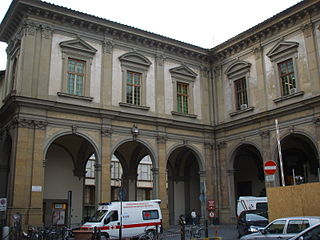
Filippo di ser Brunellesco di Lippo Lapi, commonly known as Filippo Brunelleschi and also nicknamed Pippo by Leon Battista Alberti, was an Italian architect, designer, goldsmith and sculptor. He is considered to be a founding father of Renaissance architecture. He is recognized as the first modern engineer, planner, and sole construction supervisor. In 1421, Brunelleschi became the first person to receive a patent in the Western world. He is most famous for designing the dome of the Florence Cathedral, and for the mathematical technique of linear perspective in art which governed pictorial depictions of space until the late 19th century and influenced the rise of modern science. His accomplishments also include other architectural works, sculpture, mathematics, engineering, and ship design. Most surviving works can be found in Florence.

Lorenzo Monaco was an Italian painter and miniaturist of the late Gothic to early Renaissance age. He was born Piero di Giovanni. Little is known about his youth, apart from the fact that he was apprenticed in Florence. He has been considered the last important exponent of the Giotto style, before the Renaissance revolution that came with Fra Angelico and Masaccio.
Santa Maria, Sta. Maria or Santa María is a title of Mary, mother of Jesus, in languages such as Italian, Portuguese and Spanish.

The Badìa Fiorentina is an abbey and church now home to the Monastic Communities of Jerusalem situated on the Via del Proconsolo in the centre of Florence, Italy. Dante supposedly grew up across the street in what is now called the 'Casa di Dante', rebuilt in 1910 as a museum to Dante. He would have heard the monks singing the Mass and the Offices here in Latin Gregorian chant, as he famously recounts in his Commedia: "Florence, within her ancient walls embraced, Whence nones and terce still ring to all the town, Abode aforetime, peaceful, temperate, chaste." In 1373, Boccaccio delivered his famous lectures on Dante's Divine Comedy in the subsidiary chapel of Santo Stefano, just next to the north entrance of the Badia's church.

The Basilica of St. Mary of the Angels and of the Martyrs is a Catholic titular minor basilica and former Carthusian conventual church in Rome, Italy, constructed in the ruined frigidarium and tepidarium of the Roman Baths of Diocletian in the Piazza della Repubblica.

Raffaellino del Garbo (1466–1527) was a Florentine painter of the early Renaissance.

Ridolfo di Domenico Bigordi, better known as Ridolfo Ghirlandaio was an Italian Renaissance painter active mainly in Florence. He was the son of Domenico Ghirlandaio.

Cosimo Fanzago was an Italian architect and sculptor, generally considered the greatest such artist of the Baroque period in Naples, Italy.

Bernardino Poccetti, also known as Barbatelli, was an Italian Mannerist painter and printmaker of etchings.

Teodulo Mabellini was an Italian composer.

Santa Maria degli Angeli is the former church of a now-defunct monastery of that name in Florence, Italy. It belonged to the Camaldolese order, which was a reformed branch of the Benedictines. The order is based on the hermitage which was founded near Arezzo in 1012 by the hermit St. Romuald at Camaldoli, hence the name. Very little of the medieval building exists today.

San Frediano in Cestello is a Baroque-style, Roman Catholic church in the Oltrarno section of Florence, region of Tuscany, Italy. The name cestello derives from the Cistercians who occupied the church in 1628. Previously the site had a 1450s church attached to the cloistered Carmelite convent of Santa Maria degli Angeli.

The Hospital of Santa Maria Nuova is the oldest hospital still active in Florence, Italy.
Silvester of Valdiseve (1278–1348) was a medieval monk. He has been beatified by w the Roman Catholic Church. Silvester was christened Ventura and lived in Florence. He was involved in the processing of wool until the age of 40 when he became a monk. He entered the Camaldolese monastery of Santa Maria degli Angeli, also located in Florence. There, he worked as a cook.
The Monastery of St. Mary of the Angels was a monastery of the Camaldolese Order in Florence, Italy.

San Giuseppe dei Ruffi or church of San Giuseppe dei Ruffo is a church located on piazzetta San Giuseppe dei Ruffi, in Naples, Italy.
Arcangelo Guglielmelli was an Italian architect and painter, active in his native Naples, Italy, in a late-Baroque style. He was involved in the building and reconstruction of churches, many of which had been damaged by the earthquakes of 1688 and 1694.

The Hospital of the Holy Spirit is the oldest hospital in Europe, located in Rome, Italy. It now serves as a convention center. The complex lies in rione Borgo, east of Vatican City and next to the modern Ospedale di Santo Spirito. The hospital was established on the site of the former Schola Saxonum, a part of the complex houses the Museo Storico.

The Santa Maria Nuova Crucifixion is a fragment of a fresco created in 1440–41 by the early Italian Renaissance artist Andrea del Castagno. It is in the Ospedale di Santa Maria Nuova in Florence.















